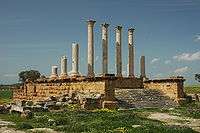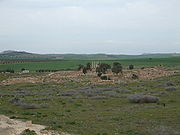
Thuburbo Majus
Encyclopedia

Ancient Rome
Ancient Rome was a thriving civilization that grew on the Italian Peninsula as early as the 8th century BC. Located along the Mediterranean Sea and centered on the city of Rome, it expanded to one of the largest empires in the ancient world....
site in northern Tunisia
Tunisia
Tunisia , officially the Tunisian RepublicThe long name of Tunisia in other languages used in the country is: , is the northernmost country in Africa. It is a Maghreb country and is bordered by Algeria to the west, Libya to the southeast, and the Mediterranean Sea to the north and east. Its area...
. It is located roughly 60 km southwest of Carthage
Carthage
Carthage , implying it was a 'new Tyre') is a major urban centre that has existed for nearly 3,000 years on the Gulf of Tunis, developing from a Phoenician colony of the 1st millennium BC...
on a major Africa
Africa
Africa is the world's second largest and second most populous continent, after Asia. At about 30.2 million km² including adjacent islands, it covers 6% of the Earth's total surface area and 20.4% of the total land area...
n thoroughfare. This thoroughfare connects Carthage
Carthage
Carthage , implying it was a 'new Tyre') is a major urban centre that has existed for nearly 3,000 years on the Gulf of Tunis, developing from a Phoenician colony of the 1st millennium BC...
to the Sahara
Sahara
The Sahara is the world's second largest desert, after Antarctica. At over , it covers most of Northern Africa, making it almost as large as Europe or the United States. The Sahara stretches from the Red Sea, including parts of the Mediterranean coasts, to the outskirts of the Atlantic Ocean...
. Other towns along the way included Sbiba
Sbiba
Sbiba is a city in the province of Kasserine. It is the site of the ancient city of Sufes. It is famous of its apples and tomatoes....
, Sufes, Sbeitla
Sbeitla
Sbeitla is a small town in north-central Tunisia. Nearby are the Roman ruins of Sufetula, containing the best preserved Forum temples in Tunisia...
, and Sufetula. Parts of the old Roman road are in ruins, but others do remain. Romans started to build Thuburbo Majus in 27 BC
27 BC
Year 27 BC was either a common year starting on Sunday, Monday or Tuesday or a leap year starting on Monday of the Julian calendar and a common year starting on Sunday of the Proleptic Julian calendar...
.
Thuburbo Majus or Colonia Julia Aurelia Commoda, its Roman name, was originally a Punic town, later founded as a Roman veteran colony by Augustus
Augustus
Augustus ;23 September 63 BC – 19 August AD 14) is considered the first emperor of the Roman Empire, which he ruled alone from 27 BC until his death in 14 AD.The dates of his rule are contemporary dates; Augustus lived under two calendars, the Roman Republican until 45 BC, and the Julian...
in 27 BC. Military veterans were sent to Thuburbo, among other sites, by Augustus to allow them to start their post-army lives with land of their own. Its strategic location and access to trade routes made it an important establishment. Ruins of the town are in the middle of the countryside with no towns in close proximity.
Most of the town was built around 150 - 200 AD and restored in the 4th century after a 3rd century crisis. It received a Capitolium in 168 AD. The town was a productive grower of grain, olives, and fruit. Under Hadrian
Hadrian
Hadrian , was Roman Emperor from 117 to 138. He is best known for building Hadrian's Wall, which marked the northern limit of Roman Britain. In Rome, he re-built the Pantheon and constructed the Temple of Venus and Roma. In addition to being emperor, Hadrian was a humanist and was philhellene in...
it was made a municipium, helping cause a growth in wealth, and Commodus
Commodus
Commodus , was Roman Emperor from 180 to 192. He also ruled as co-emperor with his father Marcus Aurelius from 177 until his father's death in 180. His name changed throughout his reign; see changes of name for earlier and later forms. His accession as emperor was the first time a son had succeeded...
made it a colony.
Excavations

Apollo
Apollo is one of the most important and complex of the Olympian deities in Greek and Roman mythology...
, Venus
Venus (mythology)
Venus is a Roman goddess principally associated with love, beauty, sex,sexual seduction and fertility, who played a key role in many Roman religious festivals and myths...
, Silvanus
Silvanus
- People :*Marcus Plautius Silvanus , Roman consul in 2 BC*Tiberius Plautius Silvanus Aelianus, a Roman patrician serving twice as consul *Marcus Caeionius Silvanus - People :*Marcus Plautius Silvanus (1st-century BC–1st-century AD), Roman consul in 2 BC*Tiberius Plautius Silvanus Aelianus, a Roman...
, Bacchus
Dionysus
Dionysus was the god of the grape harvest, winemaking and wine, of ritual madness and ecstasy in Greek mythology. His name in Linear B tablets shows he was worshipped from c. 1500—1100 BC by Mycenean Greeks: other traces of Dionysian-type cult have been found in ancient Minoan Crete...
, the Dioscuri, and a satyr
Satyr
In Greek mythology, satyrs are a troop of male companions of Pan and Dionysus — "satyresses" were a late invention of poets — that roamed the woods and mountains. In myths they are often associated with pipe-playing....
. Three perfume vases showed dogs pursuing rabbits.
In 1920 an inscription found in Thuburbo Majus written in honor of C. Vettius Sabinianus proved that several other inscriptions bearing that name were referring to the same person.
Remains of the house of Bacchus
Dionysus
Dionysus was the god of the grape harvest, winemaking and wine, of ritual madness and ecstasy in Greek mythology. His name in Linear B tablets shows he was worshipped from c. 1500—1100 BC by Mycenean Greeks: other traces of Dionysian-type cult have been found in ancient Minoan Crete...
and Ariadne
Ariadne
Ariadne , in Greek mythology, was the daughter of King Minos of Crete, and his queen Pasiphaë, daughter of Helios, the Sun-titan. She aided Theseus in overcoming the Minotaur and was the bride of the god Dionysus.-Minos and Theseus:...
dating back to the early 5th century were excavated in 1925. Researchers found the town to be a valuable site, as evidence of food preparation in a garden was discovered. Those and other finds point to what daily life in ancient Rome might have been like. Mosaics found in the town date to the late 4th century. These mosaics depict items from nature, like a still life
Still life
A still life is a work of art depicting mostly inanimate subject matter, typically commonplace objects which may be either natural or man-made...
arrangement of food items and a sea filled with fish as young people fish from boats. Another mosaic represents a nude Venus riding a chariot, with plant life surrounding her to represent well-being and fertility.
This town does not have fully restored buildings, but there are remains of a forum, the amphitheatre, temples, baths, houses, and other sites.

